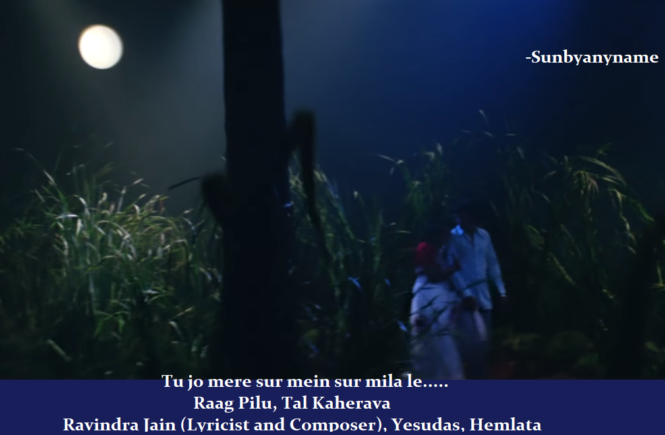Raaga Based Song of the Day: Tu jo mere sur mein sur mila le….
Raag Pilu, Tal Kaherava
After this post, I have another three to go before I finish a hundred posts in the present series before Diwali.
If you look at the image of this post you would notice the full-moon in it. Chand (Moon) is my favourite theme in songs. One of my first post on songs was ‘Hindi Songs And The Importance Of Chand (Moon)‘. Similarly, on my first Facebook group ‘Dil Ki Nazar Se’, the very first monthly music Fest was on the theme of Chand. On my second group ‘Yaad Kiya Dil Ne‘ too I have had a Fest on Chand with the difference that Chand would be actually there in the video of the song.
For the month of November 2018, I have announced a Fest on Preludes, Interludes and Codas in Chand and Chandni songs.
In the cover picture of this song, the lyrics that appear are:
Chandni raaton mein, haath liye haathon mein;
Doobe rahen ek doosre ki ras bhari baaton mein.
The song is from the 1976 Basu Chatterjee movie Chitchor. It was composed by Ravindra Jain on his own lyrics and sung by Yesudas and Hemlata.
Even though it is a very popular raaga in Hindi movies, particularly for OP Nayyar, today is the second time that I give you a song in this raaga. The first time I gave you a song in this raag was on the tenth day: Dhadakte dil ki tamanna ho mera pyaar ho tu, (Please see: ‘Raaga Based Song Of The Day #10‘). It is a beautiful composition of Ghulam Mohammad (of Pakeezah fame) on the lyrics of Kaifi Azmi in the 1961 movie Shama starring Suraiya, Nimmi and Vijay Dutt.
We have completed ninety-five days of Raaga Based Songs of the Day. Our first post in the series was titled ‘Raaga Based Song Of The Day #1’ and the song was a Mohammad Rafi and Lata Mangeshkar song from the 1970 Shakti Samanta movie Pagla Kahin Ka: Tum mujhe youn bhula na paoge. It is in Raag Jhinjhoti, Tal Kaherava.
Our ninety-sixth post or the last post here was titled ‘Raaga Based Song Of The Day #96‘ and the song was a Lata Mangeshkar song from the 1965 Raj Khosla movie Chirag starring Sunil Dutt and Asha Parekh: Teri aankhon ke siwa. It is also in Raag Jhinjhoti but Tal is Dadra.
This blog has a number of posts on Raaga based songs in Hindi movies titled similarly; for example: ‘The Best Raaga Based Songs in Hindi Movies – Raaga Darbari Kanada – Part II‘.
In the last ninety-six days of sharing Raaga based songs of the day, I have given you songs based on Raag Jhinjhoti, Gara, Bhimpalasi, Madhuvanti, Shivaranjani, Bihag, Pahadi, Sarang, Pilu, Bhairavi, Khammaj, Charukesi, Kalyan or Yaman, Desh, Malgunji, Kirwani, Kedar, Bageshri, Megh Malhar, Bhupali, Ahir Bhairav, Malkaush, Mand, Adana, Kafi, Rageshri, Jaunpuri, Tilang, Janasammohini, Chayanat, Shuddha Kalyan, Gaur Sarang, Jogiya, Asavari, Maru Bihag, Durga, Lalit, Puria Dhanashri, Bhinna Sahdja, Sohani, Multani, Patdeep, Jaijaiwanti, Tilak Kamod, Hemant, Basant Mukhari, Gujri Todi, Kalavati, Hamir, Bhatiyar, Gawati, Shyam Kalyan, Gorakh Kalyan, Madhamat Sarang, Manj Khammaj, Darbari Kanada, Vibhas, Shankara, Bahar, Nand and Mian Ki Malhar; making it a total of 61 raagas. The raagas that have been repeated so far are Pahadi, the raaga of my home place in the Himalayas, Maru Bihag, Raag Kirwani, Jhinjhoti, Bhairavi, Gara, Basant Mukhari, Malkauns, Bhairavi, Mand, Sohani, Madhuvanti, Shivaranjani and Adana. Today, I am repeating Raag Pilu for the second time.
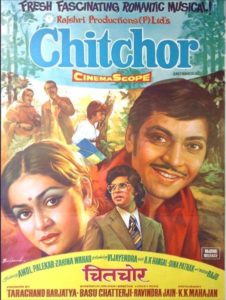 Today’s song is from the 1976 Basu Chatterjee movie Chitchor starring Amol Palekar, Zarina Wahab and Vijayendra. The film is a Rajshri Productions film produced by Tarachand Barjatya. It is based on a Bengali story, Chittachakor by Subodh Ghosh.
Today’s song is from the 1976 Basu Chatterjee movie Chitchor starring Amol Palekar, Zarina Wahab and Vijayendra. The film is a Rajshri Productions film produced by Tarachand Barjatya. It is based on a Bengali story, Chittachakor by Subodh Ghosh.
Lets understand the story-line to see where the song fits in the movie:
Geeta’s (Zarina Wahab) Mumbai based sister Meera sends a letter to Geeta’s father Pitamber (AK Hangal) that an engineer would be arriving at their village and he is a possible match for Geeta. The family dutifully receives Vinod (Amol Palekar) at the railway station. He takes an instant liking to the family, especially Geeta and even tries to teach her music and singing. The two fall in love. All seems to be going well until another letter is received from Meera informing the family that the engineer Sunil (Vijayendra) was earlier delayed and would be arriving soon. Vinod (Amol Palekar) was merely the overseer.
He was nevertheless the Heart-stealer (Chitchor) for the naive village belle Geeta. There is a happy ending for the two.
The song is lip-synced by Amol Palekar and Zarina Wahab when Vijayendra arrives from Mumbai and the family is in the process of telling Zarina Wahab to switch her attention from Amol Palekar to Vijayendra.
The lyricist of the song was Ravindra Jain and he composed the song too.
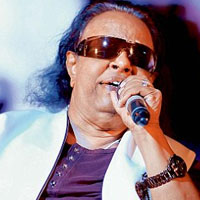
This is the first time I am taking up a song by Ravindra Jain either in this series or in ‘Songs That Tug At Your Emotions’ series.
Ravindra Jain was born on 28 Feb 1944 in Aligarh. He was born blind to Sanskrit scholar and Ayurvedacharya, Pandit Indramani Jain and mother Kiran Jain.
He started singing at a very early age singing bhajans. His parents gave him music training fairly early. Ravindra Jain received basic training under Pandit GL Jain, Pandit Janardhan Sharma, and Pandit Nathu Ram. His entry into the films world was at the age of 16 in Calcutta. Ten years later he moved to Bombay wherein he made his debut as a composer for Prathibhushan Bhattacharya’s movie Kranthi. In 1972 he became a full fledged Music Director when Mohammad Rafi recorded a song composed by him that was never released.
Jain progressed his career in the early 1970s, composing for films such as Saudagar (1973 film), Chor Machaye Shor (1974), Geet Gaata Chal (1975), Chitchor (1976), Dulhan Wahi Jo Piya Man Bhaaye (1977), Paheli (1977) and Ankhiyon Ke Jharokhon Se (1978) and Nadiya ke paar (1982). Along with composing music, he also wrote the lyrics for many of his songs. Ravindra Jain’s father died during the recording sessions of the film Saudagar. However, Jain did not leave the studio until the recordings were finalised giving utmost importance to his work.
As far as his association with Yesudas is concerned, Jain is credited for bringing this great South Indian vocalist to Hindi movies, in singing in many of his movies in the 1970s and 1980s.
It is said that Jain was so enthralled by Yesudas’s voice, if he ever received his vision, Yesudas would be the first person he would want to see. Jain has worked on songs after his liaison with Yesudas, but he has failed to attain the pinnacle of glory he achieved with the master singer during the 1970s. Jain has described Yesudas as the ‘Voice of India’.
I have posted two songs of Yesudas before in this blog: Ka karun sahani in Raag Kirwani, Tal Kaherava (Please see: ‘Raaga Based Song Of The Day #17‘) and Koi gaata main so jaata (Please see: ‘Songs That Tug At Your Emotions #23‘).
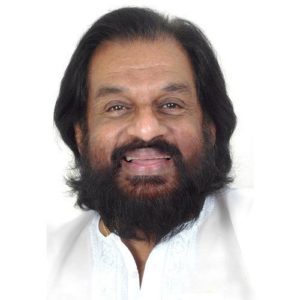
Kattassery Joseph Yesudas was born on 10th January 1940 in Fort Kochi (Kerala) in a Latin-rite Roman Catholic Christian family to late Augustine Joseph and late Elizabeth Joseph. His father, a well-known Malayalam classical musician and stage actor, was his first guru (teacher). Yesudas recorded his first popular song Jaathi Bhedam Matha Dwesham (music: MB Sreenivasan) on 14th November 1961. He got a break in Hindi movies with the 1971 movie Jai Jawan Jai Kisan. Therefore, in 2011 Yesudas completed 50 years as a playback singer. However, it was the 1976 Basu Chatterjee movie, with songs composed by Salil Chowdhury that really made him popular. The song he sang in the movie was: Jaaneman jaaneman tere do nayan. Yesudas has recorded over 70,000 songs and has won scores of accolades including the coveted Padma Shri (1975), Padma Bhushan (2002), Padma Vibhushan (2017) and a record seven National Awards for Best Playback Singer. On 2 Oct 2014, Yesudas sparked a row while speaking at a public function on the occasion of Gandhi Jayanthi, where he stated that “Women should not wear jeans and trouble others. You should dress modestly and do not behave like men”. This resulted in a number of protests from Women’s Rights and Political organizations, who asked him to withdraw the comment, which he never did.
Some of the popular songs of Ravindra Jain that have been sung by Yesudas are: Aaj se pehle, Gori tera gaanv badha pyara and Jab deep jale aana (Chitchor, 1976); Shikari raja aaye re and Utho he laal (Safed Haathi; 1977); Khushiyan hi khushiyan ho daaman mein jiske (Dulhan Wahi Jo Piya Man Bhaaye, 1977); Laal gulabi phool se bhari (Hamra Sansaar, 1978); Sabko chhuti mili mujhako mili kyun nahin and Tere honthon ke pyaale se jo chhalke (Mera Rakshak, 1978); Sunayana aaj in nazaron ko tum dekho and Aansu bhi hain khushiyan bhi hain (Sunayana, 1979); O goriyaa re, Oonchi neechi lehron ke kandhon par and Teara kuchh khoya ho to dhoond de (Naiyya, 1979); Neer bharan ka karke bahana (Gopal Krishna, 1979); Kaun hai aisa jise phoolon se (Raadha Aur Seeta, 1979); Ai mere udaas man and Ik but se mohabbat karke (Maan Abimaan, 1980); Sun sun gaon ki gori (Sasural, 1984); and Saambh sada shiv (Abodh, 1984).
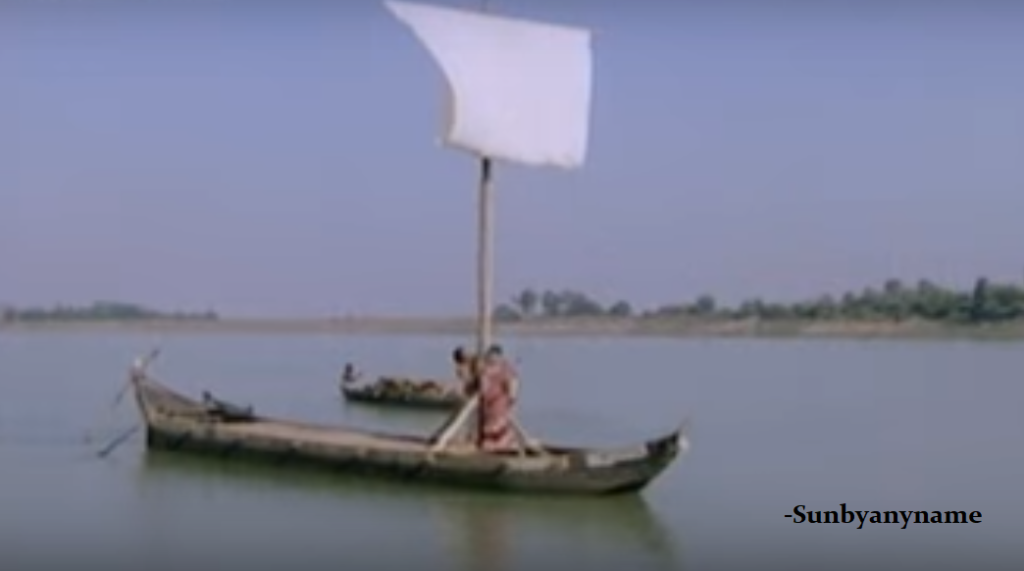
The female singer of this song is Hemlata. Whilst Yesudas won the National Award for this song, she won the Filmfare Award for it (she has won five such awards so far). Having been born on 16 Aug 1954 in Hyderabad, when she was only 12 years old her family moved to Bombay. She had early influence by Ustad Allarakha and Ustad Rais Khan; the latter taught her ghazals. But, the one person who really took her up as a singer in the movies was Naushad Ali (is there no end to how many artistes Naushad helped become good and great including the playback singer Mukesh?) Later, she worked with Roshan and Khaiyyam.
Her association with Ravindra Jain was the most lasting. He used her voice for his debut movie in 1972: Kaanch Aur Heera. She thereafter sang in many of his movies such as Raakh Aur Chingari (1974), Geeta Gaata Chal (1975), Salakhen (1975), Tapasaya (1975), and Fakira (1976). Her singing for him in Akhiyon Ke Jharokhon Se made her very popular.
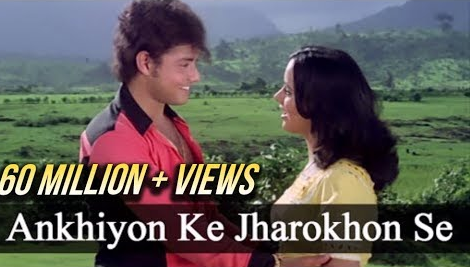
In the year 1977, when I was posted to Indian Navy’s Leadership School INS Agrani, we had the occasion to host a concert featuring both Yesudas and Hemlata. Chitchor had just been released and this song was on everyone’s lips.
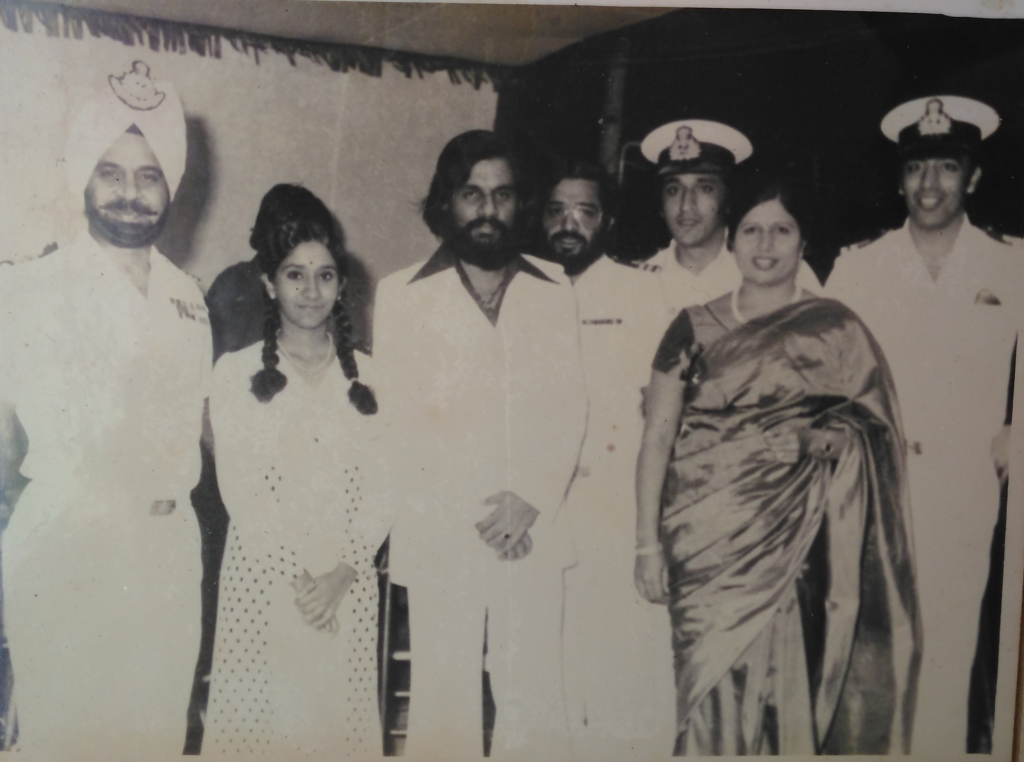
Ravindra Jain composed many memorable songs based on Raagas. One of his most memorable numbers is in Raag Kalyan, Tal Kaherava from the same movie Chitchor: Jab deep jale aana.This song, as I told you, is in Raag Pilu, Tal Kaherava.
Raag Pilu belongs to the Kafi thaat. Its Jati is Audhav – Sampoorna, which means it is pentatonic (five notes or swar) in Aaroha (ascending) and heptatonic (all seven notes or sawr) in Avroha (descending). The swar that are vrajay (missing) in Aaroha are Re (Rishab) and Dha (Dhaivat). The dominant note (Vadi) is Dhaivat that lends to this raaga a light and tranquil touch. The raaga is full of devotion and piety and as both Amol Palekar and Zarina Wahab lip-sync it you can notice these in the eyes and mannerisms of the protagonists. The raag is well suited for the third prahar of the day; that is, early evening and that’s precisely when it is played in the movie too.
One composer who used Raag Pilu extensively was Omkar Prasad Nayyar or OP Nayyar. Some of his songs (conveying the mood) of Pilu are: Jayiye aap kahan jayenge, Kabhi aar kabhi paar laaga teere nazar, Kaisa jadoo balam tune daala (my favourite Waheeda Rehman song from Guru Dutt movie 12 O’ Clock), Main soya akhiyan meeche, and Piya piya piya na laage mora jiya. But, I am not giving you any of these.
I am also not giving you Naushad’s jhule se pawan mein aayi bahaar (literally spring time) or SD Barman’s Ab ke baras bhej bhaiya ko babul or that beautiful Sujata number Kali ghata chhaye mora jiya tarsaaye.
I have, at various places earlier, told you about the Kaherava Tal and hence don’t feel the need to repeat it here.
Before we actually take up the song, first, lets take up the value added learning of today. From the last fourteen times we started learning about some of the leading personalities in Indian Classical Music or Shastriya Sangeet. The first one that we took up was Ustaad Asad Ali Khan, the finest Rudra Veena player in the country. Then we took up Pandit Hari Parsad Chaurasia, the greatest Bansuri player in the country. Then we talked about Ali Akbar Khan, the greatest Sarod player in the country. Then we took up Pandit Ravi Shankar, the greatest Sitar player in the world. Then we took up the greatest classical singer in the country (of Carnatic tradition): MS Subbulakshmi. Then, we took up the greatest classical singer in the country (of Hindustani tradition): Pandit Bhimsen Joshi. Then, we learnt about the Shehnai maestro Ustad Bismillah Khan. Then, we learnt about Annapurna Devi, a great Surbahar (bass sitar) player of Hindustani Classical Music. Thereafter, we took up Pandit Shiv Kumar Sharma, the grestest Santoor player in the country. Then we learnt a little more about Ustaad Alla Rakha Qureshi or simply Alla Rakha, the Tabla Maestro and father of Ustaad Zakir Hussain. Then we learnt about the master and one of the pioneers of fusion: Anand Shankar. Then we learnt about a Veena player who was also a great filmmaker: Sundaram Balachander. Then we learnt about Sarod Player Ustad Amjad Ali Khan. And then we learnt about Ustaad Zakir Hussain, the Tabla maestro. Then we learnt about Sitar Player and Composer Anoushka Shankar. And finally we covered vocalist Pandit Jasraj in the last post.
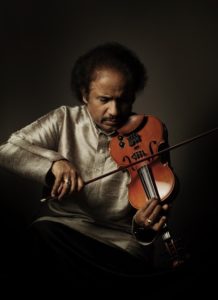
Tonight, we shall take up the great violinist: L Subramaniam. Talking about him takes me back to attending those musical concerts in the nights at St Xavier’s College, Bombay (now Mumbai). We used to sit spell bound listening to his art. Pandit Dr. Lakshminarayana Subramaniam in Madras Presidency, British India, just 22 days before India became independent.
L Subramaniam began training in violin under the tutelage of his father, Professor V Lakshminarayana. Mani, as he is fondly known by fellow musicians and his family, gave his first public performance at the age of only six.
L Subramaniam is also an MBBS from Madras Medical College and that explains the Dr in his name. He also has a Master’s degree in Western classical music, which he acquired at the California Institute of the Arts.
He is thus a unique violinist trained both in Carnatic tradition as well as Western classical tradition. Since 1973, Subramaniam has amassed over 200 recordings to his credit, releasing several solo albums, recording collaborations with musicians Yehudi Menuhin, Stéphane Grappelli, Ruggiero Ricci and Jean-Pierre Rampal, further to making albums and performing with Ruggiero Ricci, Herbie Hancock, Joe Sample, Jean-Luc Ponty, Stanley Clarke John Handy, and George Harrison.
Amongst the awards that he has won are: President’s Award for Best Violinist on All India Radio (1963), Grammy nomination for the album Indian Classical Music (1981), Padma Shri (1988), Padma Bhushan (2001), and Lifetime Achievement Award, Limca Book of Record (2012).
Returning to the song now. The song is from the 1976 Basu Chatterjee movie Chitchor. The movie was a Rajshri Production film produced by Tarachand Barjatya. Ravindra Jain has had a long association with Rajshri Production. It started with their 1975 movie Geet Gaata Chal starring Sachin and Sarika. Besides Chitchor, Ravindra Jain was Music Director for their Akhiyon Ke Jharokhon Se (1978), Tapasya (1976), Abodh (1984), Jaana Pehchana (2011). All these have very melodious numbers.
Basu Chatterjee directed the movie and the song very well. There are people at Pitamber’s house to see the engineer (Vijayendra). Amol Palekar and Zarina Wahab are putting up a song for the guest (a likely match for her). And true to the lyrics of the song as well as the bhaav of the raaga, for the loving couple there are only two people in the room: themselves.
Ladies and gentlemen, please enjoy in Raag Pilu Tal Kaherava, Yesudas and Hemlata sing a composition of Ravindra Jain on his own lyrics in the 1976 Basu Chatterjee movie Chitchor starring Amol Palekar and Zarina Wahab: Tu jo mere sur mein sur mila le…..
ये: तू जो मेरे सुर में -२
सुर मिला ले, संग गा ले
तो ज़िंदगी हो जाए सफ़ल
हे: तू जो मेरे मन का -२
घर बना ले, मन लगा ले
तो बंदगी हो जाए सफ़ल
दोनों: तू जो मेरे सुर में
ये: चाँदनी रातों में, हाथ लिए हाथों में
हे: चाँदनी रातों में, हाथ लिए हाथों में
दोनों: डूबे रहें एक दूसरे की, रस भरी बातों में
ये: तू जो मेरे संग में -२
मुस्कुरा ले, गुनगुना ले
तो ज़िंदगी हो जाए सफ़ल
हे: तू जो मेरे मन का…
दोनों: तू जो मेरे सुर में…
हे: क्यों हम बहारों से, खुशियाँ उधार लें
ये: क्यों हम बहारों से, खुशियाँ उधार लें
दोनों: क्यों न मिलके हम खुद ही अपना जीवन सुधार लें
हे: तू जो मेरे पथ में -२
दीप गा ले ओ उजाले
तो बंदगी हो जाए सफ़ल
ये: तू जो मेरे सुर में -२
सुर मिला ले, संग गा ले
तो ज़िंदगी हो जाए सफ़ल
We have intended to learn about Raaga based music whilst we entertain ourselves with Raaga based songs. So, lets, once again, take stock of our collective learning so far:
- On the first day we learnt about the Raaga system devised by Pandit Vishnu Narayan Bhatkhande, which is the prevalent system in Hindustani Classical Music and based on ten Thaats.
- On the second day we learnt about Tal or Taal.
- On the third day we learnt about characteristics of Raagas that included Swar, Jati, Thaat, Arohana and Avarohana, Vadi, Samvadi and Pakad.
- On the fourth day, we learnt about Sargam.
- On the fifth day, we learnt about notations used in Indian classical music or simply Swar Lipi.
- On the sixth day, we learnt about the Ras (sentiments) that Raagas evoke.
- On the seventh day, we learnt about various types of Swar: Shuddha, Achal, Vikrut, Komal and Teevra.
- On the eighth day, we learnt the parts of a composition in Indian Classical Music.
- On the ninth day, we learnt the names of some of the popular instruments used in Indian Classical Music.
- On the tenth day, we learnt about the sources of names of Raagas.
- On the eleventh day, we learnt about why Bhairavi is the first raag to be taught to beginners and also why it is the last in a performance.
- On the twelfth day, we learnt about Khammaj Thaat.
- On the thirteenth day, we learnt about Tal Punjabi Theka or Sitarkhani.
- On the fourteenth day, we learnt about Alap.
- On the fifteenth day, we learnt about List of Raagas (Raagmala) in my favourite book: Sri Guru Granth Sahib.
- On the sixteenth day, we learnt about tips for raaga identification.
- On the seventeenth day, we learnt the basics of Gharana system.
- On the eighteenth day, we learnt about Filmi Sangeet.
- On the nineteenth day, we learnt about the commonest Tal in Raagas: Tintal.
- On the twentieth day, we learnt about the Kafi Thaat.
- On the twenty-first day, we learnt a little more in detail about the classification of Raagas.
- On the twenty-second day, we learnt the essential differences between Bhairavi and Bhairav.
- On the twenty-third day, we learnt a little more in detail about the Jati or Jaati of a raaga.
- On the twenty-fourth day, we learnt details of Thaat Bilawal, the most basic thaat in the Bhatkhande’s system of raagas.
- On the twenty-fifth day, we learnt about Tintal.
- On the twenty-sixth day, we learnt in detail about the Raaga – Samay linkage.
- On the twenty-seventh day, we learnt about Lehar.
- On the twenty-eighth day, we learnt about the history of the Hindustani Music.
- On the twenty-ninth day, we learnt about Dhrupad.
- On the thirtieth day, we learnt about Rupaktal that I was introduced to, a few months back, by my friend Anand Desai.
- On the thirty-first day, we learnt about Khayal.
- On the thirty-second day, we learnt about Thumri.
- On the thirty-third day, we learnt about Tappa.
- On the thirty-fourth day, we learnt about Tarana.
- On the thirty-fifth day, we learnt about Tal Dipchandi (Moghali).
- On the thirty-sixth day, we learnt about Tabla.
- On the thirty-seventh day, we learnt about Kirtan.
- On the thirty-eighth day, we learnt about Pakhawaj.
- On the thirty-ninth day, we learnt about Hori.
- On the fortieth day, we learnt about Dadra.
- On the forty-first day, we learnt about Kajri.
- On the forty-second day, we learnt about Chaiti.
- On the forty-third day, we learnt about Sarangi.
- On the forty-fourth day, we learnt about Shehnai.
- On the forty-fifth day, we learnt about Sarod.
- On the forty-sixth day, we learnt about Bansuri.
- On the forty-seventh day, we learnt about Ektal and Tanpura.
- On the forty-eighth day, we learnt about Veena.
- On the forty-ninth day, we repeated our learning of Veena with a small excitement added.
- On the fiftieth day, we learnt about Dilruba/Esraj.
- On the fifty-first day, we learnt about Jaltarang.
- On the fifty-second day we learnt about Qawwali.
- On the fifty-third day, we learnt about Sitar.
- On the fifty-fourth day, we learnt about Surbahar.
- On the fifty-fifth day, we learnt about Harmonium.
- On the fifty-sixth day, we learnt about Santoor.
- On the fifty-seventh day, we learnt about Swarmandal.
- On the fifty-eighth day, we learnt about the Shruti Box.
- On the fifty-ninth day, we learnt about Alankar.
- On the sixtieth day, we learnt about singing in Aakaar.
- On the sixty-first day, we learnt about the Classification of Indian Musical Instruments.
- On the sixty-second day, we learnt a little about Carnatic Music.
- On the sixty-third day, we learnt about Natya Shastra.
- On the sixty-fourth day, we learnt about evolution of musical instruments in India down the ages.
- On the sixty-fifth day, we learnt about Riyaaz.
- On the sixty-sixth day, we looked at a list of Raagas in Hindustani Classical Music.
- On the sixty-seventh day, we learnt about the health benefits of raagas.
- On the sixty-eighth day, we learnt a little more comprehensively about the moods and emotions that raagas evoke.
- On the sixty-ninth day, we learnt about a mobile application to help identify raagas.
- On the seventieth day, we learnt about Melakarta Raagas.
- On the seventy-first day, we learnt about Sangita Makarand.
- On the seventy-second day, we learnt about TaalMala an Android application for personalized accompaniment of musical instruments during Riyaaz or even during Concert.
- On the seventy-third day, we learnt about Indian Classical Ragas, an Android application for mobile phones.
- On the seventy-fourth day, we learnt about Saregama Classical, another application for Classical Raagas.
- On the seventy-fifth day, we learnt about a free online service available to learn Indian Classical Music.
- On the seventy-sixth day, we learnt about List of Hindustani Classical Musical Festivals in India and Abroad.
- On the seventy-seventh day, we learnt about List of Carnatic Musical Festivals in India and Abroad.
- On the seventy-eighth day, we learnt about Jhaptal.
- On the seventy-ninth day, we learnt about Ektal.
- On the eightieth day, we learnt about Tivra Tal.
- On the eighty-first day, we learnt about the greatest Rudra Veena player ever: Ustaad Asad Ali Khan.
- On the eighty-second day, we learnt about the greatest Bansuri player alive: Pandit Hariprasad Chaurasia.
- On the eighty-third day, we learnt about the best Sarod player in the country: Ustaad Ali Akbar Khan.
- On the eighty-fourth day, we learnt about the greatest Sitar player in the world: Pandit Ravi Shankar.
- On the eighty-fifth day, we learnt about the greatest Indian vocalist of Carnatic tradition: MS Subbulakshmi.
- On the eighty-sixth day, we not just learnt about the greatest vocalist of Hindustani tradition: Pandit Bhimsen Joshi but also learnt about Tal Hinch.
- On the eighty-seventh day, we learnt about the Shehnai maestro Ustaad Bismillah Khan.
- On the eighty-eighth day, we learnt about Annapurna Devi, the greatest Surbahar player in India.
- On the eighty-ninth day, we learnt about Pandit Shiv Kumar Sharma, the greatest Santoor Player in the country.
- On the ninetieth day, we learnt about Ustaad Alla Rakha, the Tabla maestro.
- On the ninety-first day, we learnt about Anand Shankar, the great fusion musician from Bengal.
- On the ninety-second day, we learnt about Sundaram Balachander, the great Veena player and film-maker.
- On the ninety-third day, we learnt about Ustaad Amjad Ali Khan, the great Sarod player.
- On the ninety-fourth day, we learnt about the Tabla maestro: Ustaad Zakir Hussain.
- On the ninety-fifth day, we learnt about the Sitar player and Composer: Anoushka Shankar.
- On the ninety-sixth day, we learnt about the Vocalist Pandit Jasraj.
- And today, on the ninety-seventh day, we learnt about the great violinist L Subramaniam.
There is much more still to be learnt and enjoyed.
Please stay tuned!
